Tags
Ash, Bush Vetch, Common Vetch, cow parsley, cut-leaved crane's-bill, English Elm, garden, Germander Speedwell, horse chestnut, ivy, Muntjac fawn, Red Clover, Ribwort Plantain, Scots Pine, Small-leaved Lime, Suffolk, Thyme-leaved Speedwell, trees, white dead-nettle, wild flowers
Where has this year gone! It is nearly June already and I have been so busy and concerned for my family that I have been largely unaware of the passing of time. If it wasn’t for the photographs I have been able to take periodically I would think I had done nothing and gone nowhere.
This post will record the wild plants and trees I have in the garden. I haven’t been able to photograph any birds successfully for a few weeks and, because of the cool temperatures, there has been a distinct lack of insects other than a few hardy bees.
We have a number of English Elm saplings in our garden. The Elm has a suckering habit so we have groups of them in the scrub area near our big pond. When we first moved here in 2006 there were a few 20′ trees but those have since succumbed to Dutch Elm Disease. I can just remember the countryside when we had beautiful, stately Elm trees everywhere with their wide, domed crowns. Many of the trees had gaps where branches had been lost so they looked as though the trunks had leafy clouds on them. Not a good description I know but maybe those of you who remember Elms will know what I mean. My mother was always warned not to shelter under an Elm tree as they tended to lose branches easily.
The Scots Pine is another tree that loses branches easily. This is a little sapling we planted some years ago and hoped that it would be quite tall by now. Unfortunately it is still only about 3 foot tall and for some time we couldn’t understand why it wasn’t growing. We now believe that deer have been eating the new tips of the branches and have been pruning it. We are trying to protect it with a tall ring of mesh.
I love the look of ivy. The different shades of green of the new and older leaves, the pale veins and the exciting leaf-shape. The upper leaves are oval and many people don’t believe they belong to the same plant. It is such a useful plant to have in the garden. It provides food and shelter to so many creatures and is useful greenery when I reluctantly have to provide flowers for church.
The seedheads are food for Goldfinches and other seed eaters.
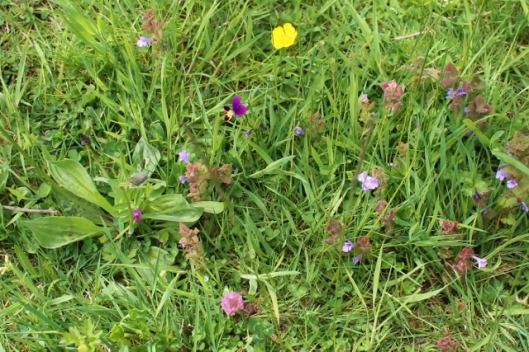
Wild flowers. In this small patch there is Common Vetch, Creeping Buttercup, Heart’s-ease, Red Clover, Ground Ivy, Greater Plantain leaves and grasses.
This is a little plant that is often over-looked but the leaves alone are quite beautiful.
We have four small Small-leaved Lime trees which were a birthday present to me a couple of years ago. I think the red buds are lovely.
The final photo is a Muntjac fawn we saw a few evenings ago. It was alone and only stayed for a few minutes.
Thank-you for visiting!

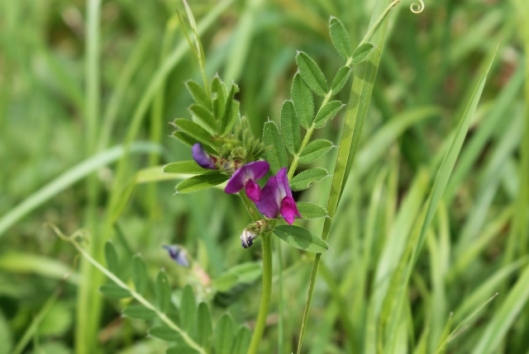
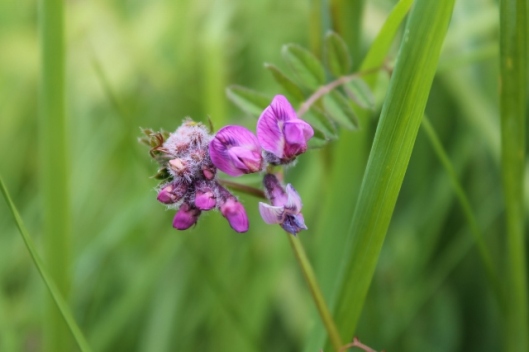

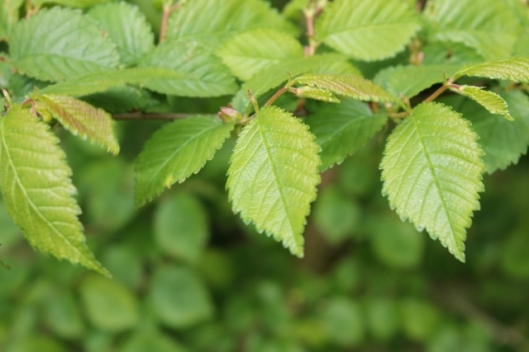
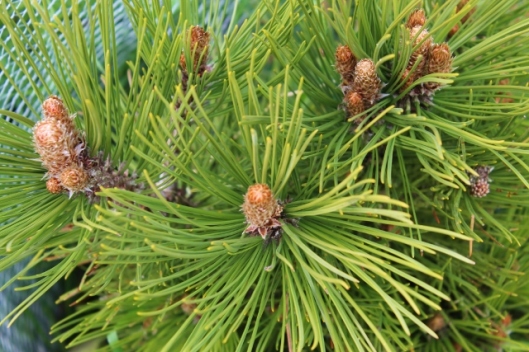

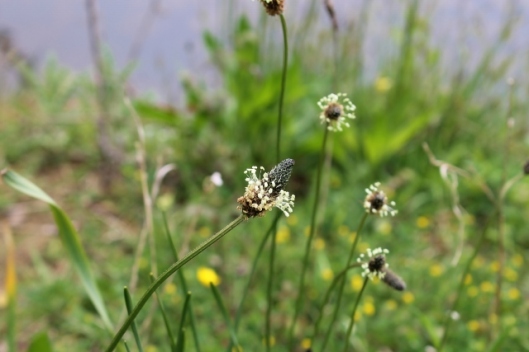
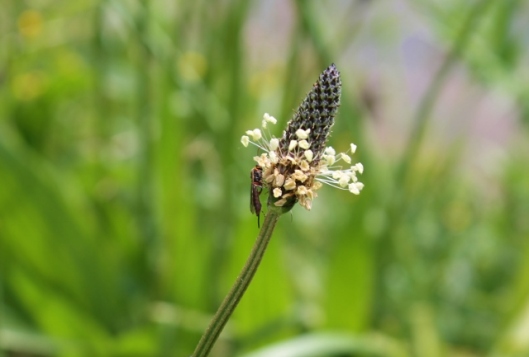

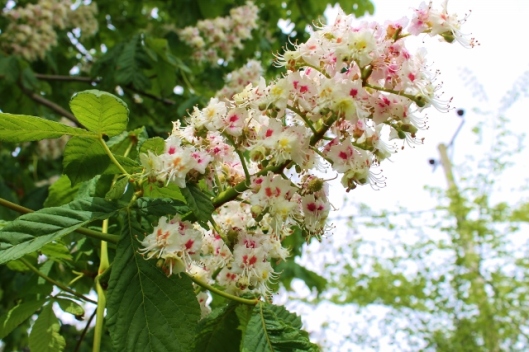


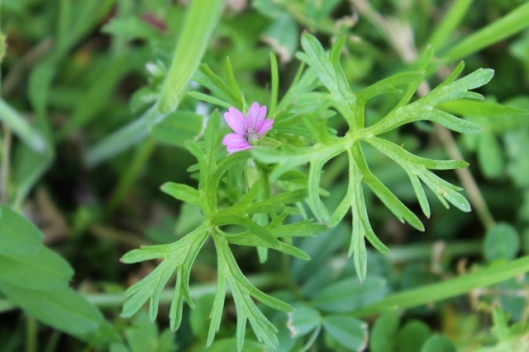

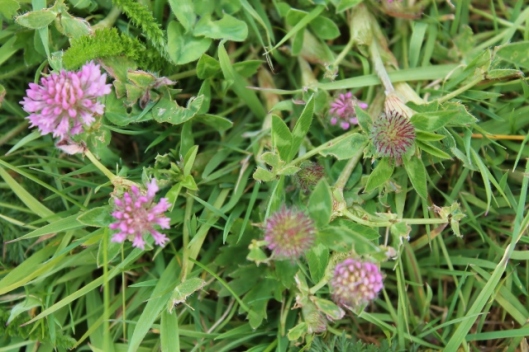
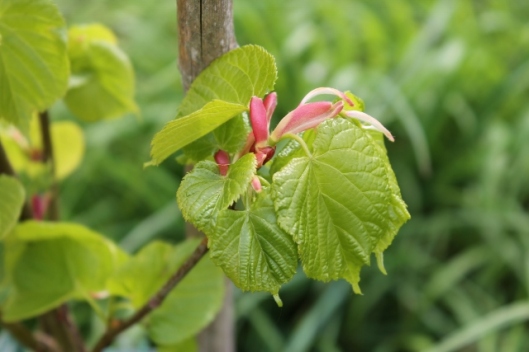

I love all the flowers that you have in your yard, I wish forepeople would make their yards as wildlife friendly as you have!
LikeLiked by 1 person
Thank-you Jerry. Richard isn’t as keen as I am I think, and would prefer a neater and more traditional garden but the flowers are very insistent and there is no getting rid of most of them! They bring in so many different insects and birds which is really quite exciting!
LikeLike
Very much enjoyed seeing all the wild plants and trees in your garden as well as the tiny fawn. The ivy is a pest/invasive plant here. It has invaded our place from the neighbours. There’s not much I can do about it except pick it for vases and flower arrangements. I may just do that tomorrow. The vases are empty, and the house would benefit from some cheery green.
LikeLiked by 1 person
Thank-you! Ivy does take some getting rid of I must admit. We let it do what it wants in the wild places and the hedges but do battle when it tries to grow in the flowerbeds and up the house. It is a little toxic so take care when using it!
LikeLiked by 1 person
Indeed. I can tolerate it on the fence but I get rather cranky when it pushes up in my garden beds.
LikeLiked by 2 people
Oh yes! Those roots can go so deep and there seems to be no way of digging it all out.
LikeLiked by 1 person
Lovely post Clare, your garden has a wonderful array of wildflowers and your Horse chestnut tree must look magnificent right now. I haven’t seen any red clover in flower yet, you are further ahead than us but Ribwort plantain is putting up flower heads here and I love them, such a pretty plant. We have a couple of small leaved Elm trees in our lane. Lovely shot of the muntjac fawn, we do not see large mammals in our garden, that must of been a treat.
LikeLiked by 1 person
Thank-you Julie! Our wild flowers insist on sharing the garden with us. My husband isn’t as keen as I am and likes to mow and strim to keep most of the place looking tidy but I hope to keep some of them round the big pond and up by the hedges. The fawn was so sweet! Richard thinks I’m a hypocrite (I am really) as I get so cross when the deer eat my plants and chew the bark off the trees.
LikeLike
A wonderful variety and so informative. Have returned to Spain and my veg garden has been overgrown by that common n garden common vetch! Am sure it wasn’t here last year…..
LikeLiked by 2 people
This may sound nutty, but some organic growers plant vetch, mow or knock down after flowering, and plant veggies right into it, using the vetch as a mulch and fertilizer for the crop. (I just found that out, and couldn’t resist sharing.)
LikeLiked by 1 person
Thanks as I was wondering about that. It is about waist high though at the moment. If I had been here could have dug it in earlier.
LikeLiked by 2 people
You could still cut back the tops and compost them and dig in the roots. Vetch is a member of the pea family and like peas and beans the roots have nodules which retain nitrogen which is so good for vegetable plots.
LikeLike
I don’t think you need to dig it in. I feel sorta bad about giving unwanted advice, so I will stop here. 😉
LikeLiked by 1 person
Your advice/suggestions are always valid
LikeLike
Don’t worry I usually end up doing what I can and have scythed it down so I can see the veg patch! As to the soil well we will just have to wait and see if it improves…
LikeLiked by 2 people
We always dig in our pea and bean stalks and roots because they store nitrogen which then replenishes the soil. Much easier and cheaper than buying additives!
LikeLiked by 1 person
Thank-you! The vetch may have been dormant in the soil and was just waiting for the right conditions to grow. Take advantage of it! It may not look quite what you expect a veg garden to look like but it is good for the soil when dug in and if left on the surface it won’t do any harm and can be used as a mulch as Aggie says and will also help stop the soil from drying out so quickly.
LikeLike
Thanks. I have scythed some paths through and will use the rest for compost and coverage against soil drying out. And left some bits as it is pretty.
LikeLiked by 1 person
I grew up in a house surrounded by elm trees. All but two were lost to the disease, and I spent many hours in my swing under those trees. It felt like they had souls.
LikeLiked by 1 person
I do so understand, Aggie! I feel the same about them and so did the ancient peoples who thought of them as spirits or gods who had been transformed.
LikeLiked by 1 person
I believe they are.
LikeLiked by 1 person
My early childhood was spent in a home bordered by stately Ash trees and I have always loved them. Clare my mind quietened as I sat looking at your photographs…thank you very much for those moments of peace this morning. Much love and hugs to. ❤ xX
LikeLiked by 1 person
Thank-you Jane, my pleasure. I love Ash trees (though their seeds get everywhere in the autumn) and am saddened to think they also may be dying out like the Elm trees have done.
LikeLiked by 1 person
Yes Clare, that is so sad…our childhood home was called ‘Ashdene’ and it was a lovely and safe place to be….happy memories. Hugs for you Xx
LikeLiked by 1 person
A lovely name for a home! Hugs and love to you dear Jane xx ❤
LikeLiked by 1 person
What lovely Engliish country wild flowers and what a precious little deer. As a gardener it’s fine to have a love-hate relationship with them. They have been cutting down all the ash trees in our area because of the emerald Ash borer😥.
LikeLiked by 1 person
These poor trees! They are suffering so much lately and what we will do without them I can’t imagine! Thank-you so much for your comment.
LikeLiked by 1 person
Lovely photos, and a bit like walking around my own garden! But I think you have bigger trees. I also have Herb Robert which I don’t think I saw in your photos. At last we have had a couple of warmer days and the grown on everything has been amazing, warmth and water – they don’t ask for much.
LikeLiked by 1 person
Thank-you! We do have Herb-Robert but none of my photos came out very well. Herb-Robert is another one of those plants that get everywhere and people don’t really notice unless they are like you and me. The warmth today is wonderful after yesterday and still it isn’t as warm as it usually is at this time of year!
LikeLiked by 1 person
Thank you for this beautiful post, Clare. I feel completely relaxed now. 🙂 The photos are amazing.
LikeLiked by 1 person
Thank-you so much Jill, I’m glad you enjoyed it! 🙂
LikeLike
I grew up under elm trees and in fact Keene used to be called “the elm city.” Then the Dutch elm disease cam along and took most of them. They were messy trees though, as you’ve reminded me. It seems that leaves, seeds, bark and limbs were always falling off them.
You’ve got some beautiful plants and flowers in your yard. Those are great shots of the speedwells. I know how small those flowers are and how hard it is to get a good shot of them!
I like the plantain shots too. Another one that isn’t easy!
LikeLiked by 1 person
Thank-you Allen. I am hoping that one day botanists will discover why some trees don’t succumb to Dutch Elm Disease. We may then see Elms growing in the landscape again.
LikeLike
We have a couple of disease resistant elms here. One is the liberty elm and I forget the name of the other. It’s hard to replace a 200 year old tree, but maybe future generations will get to see what I once saw when the giant elms used to arch over our streets and turn them into tunnels.
LikeLiked by 1 person
Oh yes; that is a wonderful thought! Cornwall in the SW of England (so another blogger tells me) has many ancient Elm trees. I asked why he thought that the disease hadn’t killed them and he suggested that there is no through-traffic spreading the disease as Cornwall is ‘land’s end’. The county is sparsely populated (though very popular as a holiday destination). The prevailing wind from the SW is straight off the Atlantic and is fairly pure air. This all could have something to do with it.
LikeLike
It could indeed! They’re very lucky to still have those elms.
LikeLiked by 1 person
June is already knocking our door, and I’m glad since this May is being colder than winter itself! If only I had your flowers too… 🙂
LikeLiked by 1 person
Thank-you Lily! It has been very cool and windy here I hope June will be warmer 🙂
LikeLike
By coincidence, I met a friend today who was trying to put a name to some ribwort plantains beside the path. I shall be able to impress her with my knowledge now thanks to you.
LikeLiked by 1 person
Pleased to be of service!
LikeLike